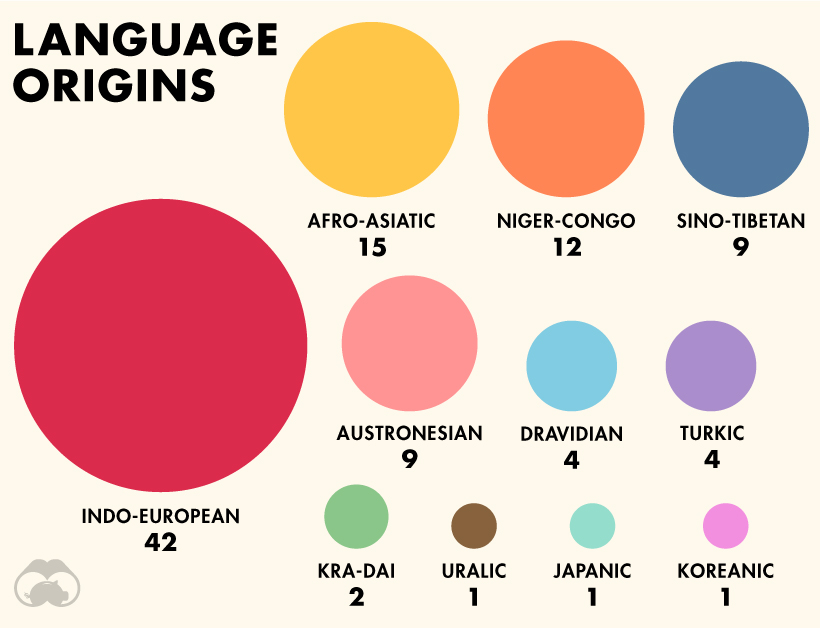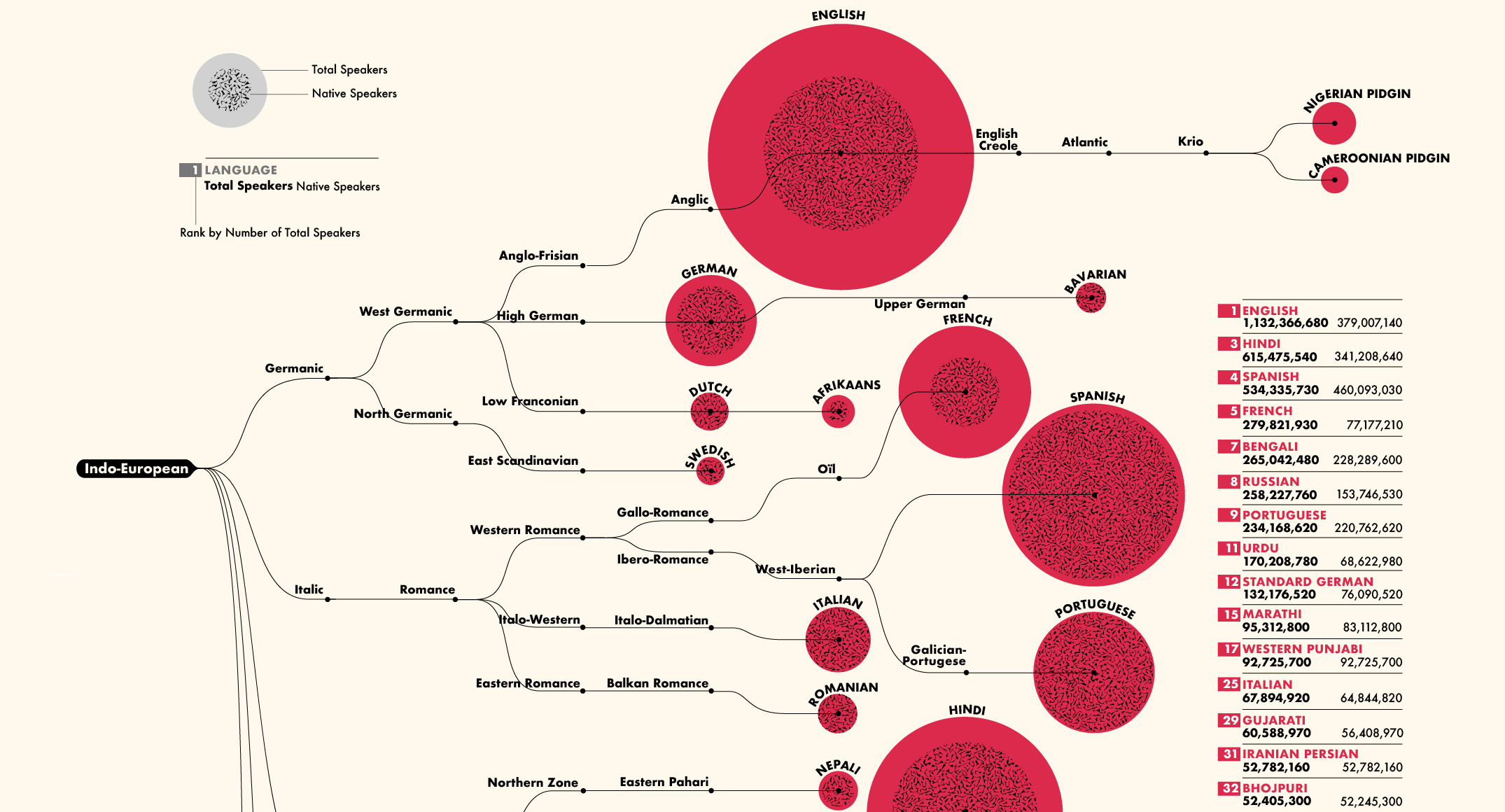Ranked: The 100 Most Spoken Languages Around the World
Mục Lục
Ranked: The 100 Most Spoken Languages Worldwide
Even though you’re reading this article in English, there’s a good chance it might not be your mother tongue. Of the billion-strong English speakers in the world, only 33% consider it their native language.
The popularity of a language depends greatly on utility and geographic location. Additionally, how we measure the spread of world languages can vary greatly depending on whether you look at total speakers or native speakers.
Today’s detailed visualization from WordTips illustrates the 100 most spoken languages in the world, the number of native speakers for each language, and the origin tree that each language has branched out from.
How Do You Define A Language?
The data comes from the 22nd edition of Ethnologue, a database covering a majority of the world’s population, detailing approximately 7,111 living languages in existence today.
The definitions of languages are often dynamic, blurring the lines around a singular understanding of what makes a language:
- Linguistic: focused on lexical and grammatical differences, or on variations within speech communities
- Social: focused on cultural or political factors, as well as heritage and identity
For the purposes of measurement, the researchers use the ISO 693-3 set of criteria, which accounts for related varieties and dialects—ensuring that linguistics are not the only factor considered in this count of languages.
Here are the language origins of the 100 most spoken languages:

Indo-European languages have the widest spread worldwide. According to Ethnologue, the language family contains over 3 billion speakers in total. Interestingly, there are actually 1,526 Niger-Congo languages altogether, though only 12 are represented here.
Let’s now dive into the top 10 most spoken languages overall.
Which Languages Have the Most Speakers?
It comes as no surprise that English reigns supreme, with over 1.1 billion total speakers—or roughly 15% of the global population. Mandarin Chinese, Hindi, Spanish, and French round out the top five.
RankLanguageTotal SpeakersLanguage Origin
1English1,132 millionIndo-European
2Mandarin Chinese1,117 millionSino-Tibetan
3Hindi615 millionIndo-European
4Spanish534 millionIndo-European
5French280 millionIndo-European
6Standard Arabic274 millionAfro-Asiatic
7Bengali265 millionIndo-European
8Russian258 millionIndo-European
9Portuguese234 millionIndo-European
10Indonesian199 millionAustronesian
However, this is only one piece in the full fabric of languages.
The metrics for native speakers tell a slightly different tale, as Mandarin Chinese shoots up to 918 million—almost 2.5x that of English native speakers.
RankLanguageNative SpeakersLanguage Origin
1Mandarin Chinese918 millionSino-Tibetan
2Spanish460 millionIndo-European
3English379 millionIndo-European
4Hindi341 millionIndo-European
5Bengali228 millionIndo-European
6Portuguese221 millionIndo-European
7Russian154 millionIndo-European
8Japanese128 millionJapanic
9Western Punjabi93 millionIndo-European
10Marathi83 millionIndo-European
Note: No native speaker data was available for Filipino, Standard Arabic, Nigerian Pidgin, or Cameroonian Pidgin.
Here, Spanish comes in strong second for native speakers with 460 million, considering it’s well-used across Latin America. The Indian languages of Hindi and Bengali cap off the top five by native speakers as well.
These are the biggest languages people learn growing up, but what about the ones they pick up later in life?
What About Second (L2) Languages?
Nearly 43% of the world’s population is bilingual, with the ability to switch between two languages with ease.
From the data, second language (L2) speakers can be calculated by looking at the difference between native and total speakers, as a proportion of the total. For example, 66% of English speakers learned it as a second language.
Swahili surprisingly has the highest ratio of L2 speakers to total speakers—although it only has 16 million native speakers, this shoots up to 98 million total speakers. Overall, 82% of Swahili speakers know it as a second language.
Swahili is listed as a national or official language in several African countries: Tanzania, Kenya, Uganda, and the Democratic Republic of Congo. It’s likely that the movement of people from rural areas into big cities in search of better economic opportunities, is what’s boosting the adoption of Swahili as a second language.
Indonesian is another similar example. With a 78% proportion of L2 speakers compared to total speakers, this variation on the Malay language has been used as the lingua franca across the islands for a long time. In contrast, only 17% of Mandarin speakers know it as a second language, perhaps because it is one of the most challenging languages to learn.
Keeping Language Traditions Alive
Languages are fluid, and constantly evolving—altogether, the 100 most spoken languages paint a unique picture across centuries of a changing world. Here’s the full list of these languages, by types of speakers and language origin.
RankLanguageTotal SpeakersNative SpeakersOrigin
1English1,132M379MIndo-European
2Mandarin Chinese1,117M918MSino-Tibetan
3Hindi615M341MIndo-European
4Spanish534M460MIndo-European
5French280M77MIndo-European
6Standard Arabic274MNAAfro-Asiatic
7Bengali265M228MIndo-European
8Russian258M154MIndo-European
9Portuguese234M221MIndo-European
10Indonesian199M43MAustronesian
11Urdu170M69MIndo-European
12Standard German132M76MIndo-European
13Japanese128M128MJapanic
14Swahili98M16MNiger-Congo
15Marathi95M83MIndo-European
16Telugu93M82MDravidian
17Western Punjabi93M93MIndo-European
18Wu Chinese82M81MSino-Tibetan
19Tamil81M75MDravidian
20Turkish80M69MTurkic
21Korean77M77MKoreanic
22Vietnamese77M76MAustronesian
23Yue Chinese74M73MSino-Tibetan
24Javanese68M68MAustronesian
25Italian68M65MIndo-European
26Egyptian Spoken Arabic65M65MAfro-Asiatic
27Hausa63M44MAfro-Asiatic
28Thai61M21MKra-Dai
29Gujarati61M56MIndo-European
30Kannada56M44MDravidian
31Iranian Persian53M53MIndo-European
32Bhojpuri52M52MIndo-European
33Southern Min Chinese50M50MSino-Tibetan
34Hakka Chinese48M48MSino-Tibetan
35Jinyu Chinese47M47MSino-Tibetan
36Filipino45MNAAustronesian
37Burmese43M33MSino-Tibetan
38Polish40M40MIndo-European
39Yoruba40M38MNiger-Congo
40Odia38M34MIndo-European
41Malayalam38M37MDravidian
42Xiang Chinese37M37MSino-Tibetan
43Maithili34M34MIndo-European
44Ukrainian33M27MIndo-European
45Moroccan Spoken Arabic33M27MAfro-Asiatic
46Eastern Punjabi33M33MIndo-European
47Sunda32M32MAustronesian
48Algerian Spoken Arabic32M29MAfro-Asiatic
49Sudanese Spoken Arabic32M32MAfro-Asiatic
50Nigerian Pidgin30MNAIndo-European
51Zulu28M12MNiger-Congo
52Igbo27M27MNiger-Congo
53Amharic26M22MAfro-Asiatic
54Northern Uzbek25M25MTurkic
55Sindhi25M25MIndo-European
56North Levantine Spoken Arabic25M25MAfro-Asiatic
57Nepali25M16MIndo-European
58Romanian24M24MIndo-European
59Tagalog24M24MAustronesian
60Dutch23M23MIndo-European
61Sa’idi Spoken Arabic22M22MAfro-Asiatic
62Gan Chinese22M22MSino-Tibetan
63Northern Pashto21M21MIndo-European
64Magahi21M21MIndo-European
65Saraiki20M20MIndo-European
66Xhosa19M8MNiger-Congo
67Malay19M16MAustronesian
68Khmer18M17MAustronesian
69Afrikaans18M7MIndo-European
70Sinhala17M15MIndo-European
71Somali16M16MAfro-Asiatic
72Chhattisgarhi16M16MIndo-European
73Cebuano16M16MAustronesian
74Mesopotamian Spoken Arabic16M16MAfro-Asiatic
75Assamese15M15MIndo-European
76Northeastern Thai15M15MKra-Dai
77Northern Kurdish15M15MIndo-European
78Hijazi Spoken Arabic15M15MAfro-Asiatic
79Nigerian Fulfulde14M14MNiger-Congo
80Bavarian14M14MIndo-European
81Bamanankan14M4MNiger-Congo
82South Azerbaijani14M14MTurkic
83Northern Sotho14M5MNiger-Congo
84Setswana14M6MNiger-Congo
85Souther Sotho14M6MNiger-Congo
86Czech13M11MIndo-European
87Greek13M13MIndo-European
88Chittagonian13M13MIndo-European
89Kazakh13M13MTurkic
90Swedish13M10MIndo-European
91Deccan13M13MIndo-European
92Hungarian13M13MUralic
93Jula12M2MNiger-Congo
94Sadri12M5MIndo-European
95Kinyarwanda12M12MNiger-Congo
96Cameroonian Pidgin12MNAIndo-European
97Sylheti12M10MIndo-European
98South Levantine Spoken Arabic12M12MAfro-Asiatic
99Tunisian Spoken Arabic12M12MAfro-Asiatic
100Sanaani Spoken Arabic11M11MAfro-Asiatic
One reason these languages are popular is that they are actively and consistently used. Unfortunately, nearly 3,000 (about 40%) of all languages are at risk of being lost, or are already in the process of dying out today.
Languages play a crucial role in our daily lives. … [Their] losses have huge negative impacts indigenous peoples’ most basic human rights.
—UN, IYoIL statement
As a result, the United Nations declared 2019 the International Year of Indigenous Languages (IYoIL), with a resolution to continue fostering these languages and pass on their knowledge for future generations.
















![Toni Kroos là ai? [ sự thật về tiểu sử đầy đủ Toni Kroos ]](https://evbn.org/wp-content/uploads/New-Project-6635-1671934592.jpg)


